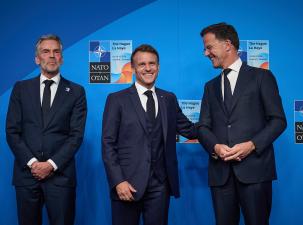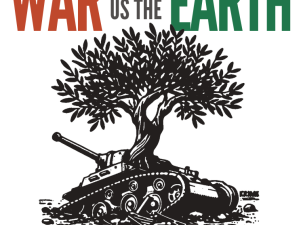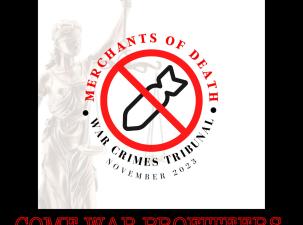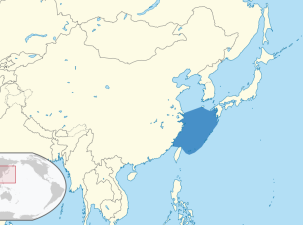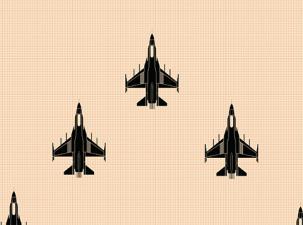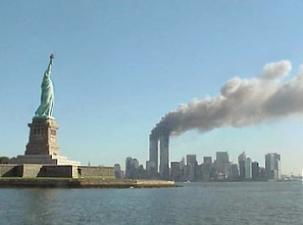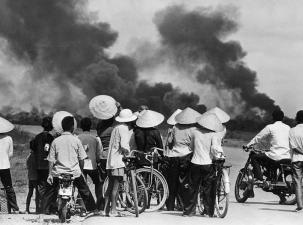Military

➡️ MILITARY & DEFENCE – Rethinking Security & Peaceful Alternatives
Global military spending is at a record high of $2443 billion. Increasing international tensions, militarisation, the military-industrial complex, and the greed of private weapons contractors have caused military budgets to bloat at the expense of other societal needs such as education, healthcare, and infrastructure.
Increased militarism only promotes national interests and creates a cycle of tension and conflict as nations continually arm themselves in response to perceived threats. As more money is pumped into the war industry, the risks of military dictatorships, rights violations, and repressive regimes increase.
Jump straight to our resources on the ➡️ Military
Explore our comprehensive guides on -
-
Arms Trade & The Arms Industry
-
Country-by-Country Defence Guide
-
The War on Terror and Major Historical Wars
-
Global Campaign on Military Spending (GCOMS) & other Peace NGOs
In addition to the death, destruction, and suffering that militaries and wars cause, they also contribute to environmental degradation and climate change, causing long-lasting damage to human health, biodiversity, and ecosystems. If we reap what we sow, why do world leaders consistently sow the seeds of conflict and war?
The military's role in defence and security must shift its focus to peacebuilding and conflict resolution. The capacity for humanitarian intervention by the military is huge, especially in times of disaster. Aid, rescue, emergency relief, post-conflict reconstruction, and enforcing peace agreements and disarmament campaigns are positive ways the military can protect civilians and reduce the risk of future conflict.
Follow our excellent Twitter list on the military for up-to-the-minute insight from security experts, international relations and foreign policy specialists, nonviolence activists, and voices from the peace movement.
German speakers can visit our partner site Bessere Welt Info for 8,000 links on the Militär from a European and peace perspective.

The Largest Defence Budgets in the World
-
UNITED STATES - The U.S. military budget reached $2.4 trillion in 2024. Accounting for 39% of all military spending in the world! It places them in the top spot, which is three times the amount runner-up China spends. Find extensive information on U.S. military budgets, military bases, the extortionately expensive F-35 fighter jets, the Military-Industrial-Congressional-Media Complex, women in the U.S. Army, critical analysis, and war veterans. The U.S. is also the world's number one arms exporter. Explore more on U.S. war profiteers, private military companies, U.S. imperial wars, and U.S. nuclear weapon stockpiling.
-
CHINA - In second place, China budgeted $471 billion for military expenses in 2024. Based on active personnel, China has the world's largest military force. Concerns over tensions with Taiwan and the increasing Cold War mentality with the U.S. from both sides are concerning, especially given its large arsenal and possession of nuclear weapons.
-
RUSSIA - The military is a top priority in Russia, with $140 billion budgeted in 2024 for security and defence purposes. The war in Ukraine has plunged the Russian military and many controversies into the spotlight, such as war crimes, nuclear war threats, mandatory conscription, and Russia's mercenary Wagner group and their presence in Africa.
-
INDIA - The fourth largest military budget is India at $78 billion. India is also a nuclear state and has huge numbers of military personnel. Controversy surrounds their youth military recruitment scheme Agnipath, conflict in Kashmir, and tensions with Pakistan.
-
GREAT BRITAIN - Spending $57 billion in 2024 and committed to increasing their nuclear arsenal, learn more about the UK military budget, the Poppy Appeal, U.S. relations and foreign policy, Trident, and AUKUS, the security pact tying the UK to the U.S. and Australia.
Check out our complete country-by-country guides on militaries around the world featuring top issues such as EU militarization, tensions in the Middle East, Central and South American defence, and military developments in Africa.
Disarmament - The Pathway to Peace
Disarmament is the act of reducing, limiting, or abolishing weapons. It contributes to global peace by limiting the potential for conflict. By halting arms production and repurposing existing weapons for peaceful uses, the likelihood of conflict and war decreases, creating an environment where diplomacy and peaceful negotiations can exist. Countries like Costa Rica and Grenada are role models in disarmament and demilitarisation.
Learn more about the global efforts for disarmament through our recommended news sources, as well as important information on international treaties and the concepts of anti-militarism and demilitarisation. Search by region for key resources, national organisations, campaigns, reports, books, and videos.

NATO Expansion - Deterrence or Threat to Security?
With 32 members, NATO is the world’s largest military alliance. Learn more about security conferences, pro-war budgets, the nuclear no-first-use protocol, the debate for Nato disarmament, and the campaigns saying No to NATO.
In 2024, the combined defence expenditure for Nato members reached $380 billion – the highest amount ever. This record spending, coupled with Eastward expansion, is concerning and poses a threat to global stability and peace, especially regarding Russia and China.
Weapons Exports & the Business of Death
Arms exports and the arms industry fuel conflict, human rights abuses, violations of international humanitarian law, repression, displacement, death and suffering. Despite this, the global value of weapons production, investment in high-tech weapons manufacturing, and the sale and transfer of this equipment are worth a staggering $138 billion.
Learn about the NGOs calling for accountability, regulation, and a stop to the madness, such as CAAT and the Anti-War Coalition. Find information on the UN Conference of the Arms Trade Treaty, arms dealers, illegal trafficking, arms fairs, and those profiting from death in the name of collective security.
The world's biggest arms exporters are:
-
U.S.A - 43%
-
France - 9.6%
-
Russia - 7.8%
-
China - 5.9%
-
Germany - 5.6%
-
Italy - 4.8%
-
United Kingdom - 3.6%
WARS - The Ultimate Form of Terrorism
We believe that war is never the answer - there is no form of just war. The only winners are the weapons contractors, stockholders, and the war industry, who line their pockets with taxpayers' money, leaving citizens as the losers.
In this section, you will find a detailed history of wars and conflicts, including WWI and WWII, as well as the Vietnam War. Learn about the devastating price veterans pay for their countries and excellent peace campaigns such as Veterans for Peace. We also highlight the atrocities of war crimes, crimes against humanity, various conventions and tribunals, and information on prisoners of war.

The War on Terror - War is Terror!
In response to the 9/11 attacks that took place in 2001, the U.S. military spent $8 trillion over 20 years funding its War on Terror in Afghanistan and Iraq. It was sold to American taxpayers through the creation of enemies to justify such enormous spending in a country already struggling to meet the social needs of its citizens.
The result of their efforts was 4.5 million deaths, 15.1 million refugees, a 270% increase in the number of terrorists and Jihadists since 2001, hatred, misery, destruction, despair, corruption, the reversal of women’s rights, total loss of safety, and unimaginable hardship.
1.8 million U.S. veterans were registered disabled, and 600,000 have been diagnosed with post-traumatic stress disorder (PTSD). The intense intelligence gathering that took place via mass surveillance undermined the civil rights and privacy of ordinary American citizens.
Check out our U.S. Military Prodigal Spending and Peaceful Alternatives blog for more information.
The U.S. military receives $1,000 for every $1 dedicated to peace efforts (not including UN efforts). This stark difference brings into question U.S. motives for their promotion of global security. The War on Terror was a racket. It purposely left U.S. citizens uninformed and misled by propaganda to enable the extraction of even more money for the U.S. war industry.
Weapon Systems & Killer Drones - Modern Warfare
Developments in technology and massive investments in the weapons industry have made warfare even more deadly and the threat of war even more terrifying.
Under the guise of national security, weapons programmes worldwide have embraced the use of artificial intelligence, killer drones and robots, and national and international missiles. Cyber warfare has the potential to cause untold damage to critical infrastructure and systems.
Highly destructive depleted uranium weapons result in serious health and environmental issues for many years to come and are of huge concern due to their lack of regulation. Learn about the devastating impacts of cluster munitions, landmines, missiles and the incredibly expensive and controversial Eurofighter programme.

Weapons of Mass Destruction
Better World Info supports a complete ban on all Atomic weapons, their manufacturing, sale, and use. Be sure to check out our huge guide to nuclear disarmament, where you will find over 4,000 resources on nukes, the dangers and outrageous costs of them, and the campaigns and initiatives fighting for an outright ban.
Biological weapons contain bacteria, viruses, or toxins that spread through the environment and cause diseases among people, animals, and plants. The effects can be deadly, and biowarfare is now prohibited by the 1972 Biological Weapons Convention.
Chemical weapons were first used on a large scale during World War I and are prohibited by international law and the Chemical Weapons Convention due to their devastating and indiscriminate effects. Nerve gases, blister agents, and choking agents cause immense suffering, permanent harm and death.
The use of chemical weapons is a grave violation of human rights. Find further information on the use of chlorine gas in Douma, Syria, in 2018 and the OPCW coverup scandal.

Beyond the Battlefield - Fund Peace Not War
We believe that this cycle of posturing and weapons proliferation must end. It is no coincidence that the five nuclear states have some of the largest military budgets AND are the largest profiteers of weapons exports. We must hold governments and their militaries accountable for the humanitarian crises they create.
"The world is over-armed and peace is under-funded," - Ban Ki-moon.
By giving peace a budget instead, we can transform a culture of war into a force for peace. Retraining military personnel in conflict resolution, human rights, and international humanitarian law fosters a mindset with peace at its core and prioritizes dialogue over violence.
Time and time again, we have seen in countless conflict regions that there are no winners in war. Better World Info actively stands up for peace, against the war industry, war propaganda, the buildup of massive arms stockpiles, and outrageous military budgets.
“A nation that continues year after year to spend more money on war, than on programs of social uplift is approaching spiritual death." - Martin Luther King.
Better World Info is an open platform – We invite experts, NGOs, campaigners, and activists to contribute their knowledge and top resources! We are a constantly expanding, work-in-progress, committed to spreading reliable, critical, and investigative resources to help create an informed, knowledgeable, and curious world.
Author: Rachael Mellor, 05.07.23 (Updated 24.04.25) licensed under CC BY-SA 4.0
For further reading on Militaries see below ⬇️
Info on Military
- NATO[1515]
- 9/11 Attacks & the WAR on terror[844]
- Military - by Country[3510]
- Military - Topics[590]
- Anti ABC Weapons & Missiles[403]
- ARMS TRADE = the business of death[1857]
- WARS - the ultimate form of terrorism[739]
- WEAPON Systems & Drones[2219]
- DISARMAMENT[684]
- AUKUS[123]
Hot Topics
Twitter list
Tweets by @BetterWorldInfo/lists/anti-military
Featured Organisation of the Month
The global movement against gun violence
The International Action Network on Small Arms (IANSA) is a global movement against gun violence, linking together civil society organisations that work on stopping the proliferation and misuse of small arms and light weapons. IANSA supports efforts that make people safer by reducing the demand for weapons, improving firearm regulation and strengthening controls on arms transfers.

Featured Online Resource of the Month
UNODA
The United Nations Office on Disarmament Affairs was established in 1998 and works to promote nuclear disarmament and non-proliferation; to strengthen the disarmament regimes in respect to other weapons of mass destruction; to strengthen disarmament efforts in the area of conventional weapons. On their website you can find an extensive collection of disarmament resources, including background information, data, treaty information, reports and links to other resources.
